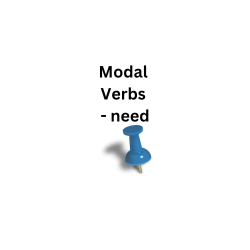Modal Verbs: need

Modal Verbs: need
Need as a Modal verb:
Need can function as a modal auxiliary verb when used in certain contexts, indicating a lack of necessity or obligation.
Here are some examples of how to use need:
Necessity and obligation:
You need to finish your homework before you can go out to play.
I need to get to the airport on time for my flight.
Lack of necessity and obligation (modal usage):
You needn’t worry about it. (negative form of need indicating no obligation or necessity)
We needn’t have gone to the meeting. (indicating that something was unnecessary in the past)
Polite requests (modal usage):
Need I remind you to take out the trash? (indicating a polite request)
Need you leave so soon? (indicating a polite request for someone to stay longer)
Note that when need is used as a modal verb, it is often followed by the base form of the verb (infinitive without to).
Need as a Modal verb in the negative:
It can also be used in the negative form needn’t to indicate a lack of necessity or obligation.
Necessity and obligation:
She needs to finish her work before the deadline.
I need to make a doctor’s appointment for next week.
They need to study more for the final exam.
Lack of necessity and obligation:
You needn’t worry about the weather; it looks like it will be sunny.
We needn’t have bothered with the extra paperwork, it wasn’t necessary.
She needn’t have come all this way just to see me.
Need as a Main Verb:
Need can also function as a main verb, meaning to require or be necessary.
When need is used as a main verb, it is typically followed by an object and an infinitive (with or without to), indicating what is needed or required.
Here are some examples: I need a new pair of shoes.
They need to hire more staff to handle the workload.
She needed some time to herself to think.
We need to finish this project by Friday.
In these examples, need is used as a main verb to express necessity or requirement.
It is followed by an object (e.g. a new pair of shoes, more staff, some time to herself, to finish this project) and an infinitive (with or without to) indicating what is needed or required.
Need as a Main verb in the question form:
In the question form, need as a main verb is typically used to ask about a requirement or necessity.
Here are some examples: Do you need any help with that?
Does the company need to update its technology?
Need we bring anything to the party?
Need you leave so soon?
Need as a main verb in a question or negative sentence:
When need is used as a main verb in a question or negative sentence, an auxiliary verb (do, does, did) is added to form the question or negative.
Here are some examples: Do you need any help with that? (question form, present tense)
Does the company need to update its technology? (question form, present tense)
Did you need any assistance earlier? (question form, past tense)
We don’t need to rush; we have plenty of time. (negative form, present tense)
He didn’t need any further instructions, he understood what to do. (negative form, past tense)
In these examples, need is used as a main verb in combination with an auxiliary verb to form a question or negative sentence.
Click here Modal Verbs: need
Click here Auxiliary Verbs: shall and will
Click here Modal Verbs: to be
Click here Modal Verbs: must
Click here Auxiliary Verbs: to have
Click here Auxiliary Verbs: to be
Click here Auxiliary Verbs
Click here Auxiliary and Modal verbs